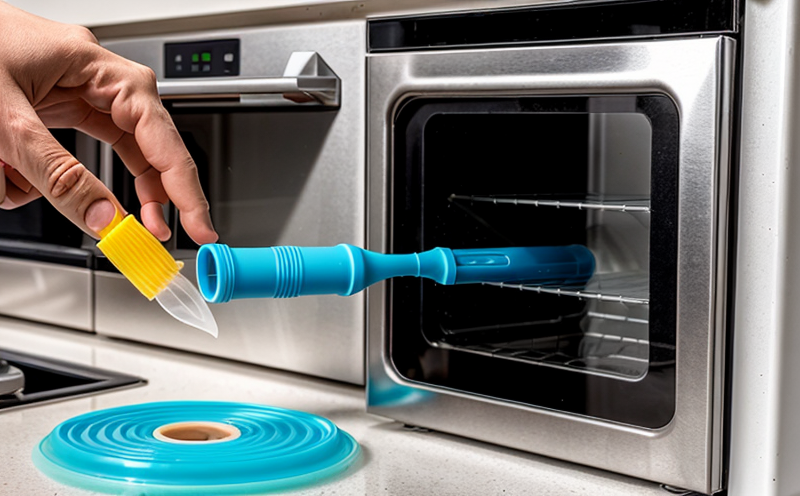ASTM D1929 Household Plastics Ignition Temperature Testing
The ASTM D1929 test method is a critical standard used to determine the ignition temperature of thermosetting plastics under specific conditions. This test is particularly important in household plastic products, as it helps ensure that materials used are safe from spontaneous combustion or ignition during normal use.
The procedure involves subjecting small samples of household plastics to controlled heating while they are confined within a defined geometry. The temperature at which the specimen ignites and sustains burning for a specified duration is recorded as the ignition temperature. This value provides essential information about the flammability characteristics of the material, which can inform design decisions in product development.
The ASTM D1929 test method is widely used by quality managers, compliance officers, R&D engineers, and procurement teams to ensure that materials meet safety standards set forth by regulatory bodies. For instance, household items such as toys, furniture, and electrical appliances are subject to this testing to ensure they do not pose a fire hazard.
The process involves precise specimen preparation, including cutting the plastic samples to standard dimensions and ensuring uniformity in thickness and shape. The test apparatus is designed to simulate real-world conditions under which household plastics might be exposed to heat sources such as open flames or high-temperature environments. This ensures that the results are relevant and can predict actual behavior in end-use applications.
The ASTM D1929 standard specifies a series of steps for conducting the test, including initial heating rates and temperature control during the ignition process. The apparatus used includes a furnace with precise temperature control capabilities to maintain the specified conditions throughout the testing period. Compliance officers rely on these tests to ensure that products comply with local and international safety regulations.
For R&D engineers, this test is invaluable for identifying potential hazards early in the product design phase. By understanding the ignition temperatures of different plastics, they can select safer materials or modify formulations to improve fire resistance without compromising other properties like strength or flexibility.
The test results provide critical data that helps in the procurement process by allowing companies to specify materials that meet specific flammability requirements. This ensures that suppliers deliver products that align with quality and safety standards expected by manufacturers and regulatory bodies.
Benefits
The ASTM D1929 test method offers numerous benefits to various stakeholders involved in the production, regulation, and use of household plastics. Here are some key advantages:
- Enhanced Product Safety: By determining ignition temperatures, this test ensures that plastic products do not pose a fire hazard during normal usage.
- Regulatory Compliance: The results help companies meet the stringent safety requirements set by regulatory bodies such as the Consumer Product Safety Commission (CPSC).
- Informed Design Decisions: Engineers can use the test data to make informed choices about material selection and product design.
- Cost Efficiency: Early identification of potentially unsafe materials through this testing process can prevent costly rework or recalls later in the production cycle.
The test also helps companies stay ahead of emerging trends and standards, ensuring they are prepared for future regulatory changes and market demands.
Why Choose This Test
Selecting the ASTM D1929 Household Plastics Ignition Temperature Testing method is advantageous for several reasons. First, it provides a standardized approach to assessing flammability that is recognized globally by industry professionals and regulatory bodies.
The test offers high precision due to its controlled environment, which simulates real-world conditions closely. This level of accuracy ensures reliable results that can be replicated across different laboratories and jurisdictions.
Furthermore, the method supports continuous improvement in product safety through regular testing and evaluation. By identifying potential risks early, companies can implement necessary changes before they lead to incidents or recalls.
The test also facilitates compliance with international standards such as ISO 17129 and EN 60335-2-84, which are essential for exporting products internationally. Meeting these standards not only enhances market access but also builds consumer trust in the safety of household plastics.
Use Cases and Application Examples
| Product Type | Purpose of Testing | ASTM D1929 Parameters |
|---|---|---|
| Plastic Toys | Evaluate safety during storage and play. | Temperature at which ignition occurs, duration of sustained burning. |
| Furniture Fabrics | Determine compliance with flammability regulations. | Ignition temperature under specified heating conditions. |
| Cables and Wiring Insulation | Ensure safe operation in potentially hot environments. | Minimum ignition temperature to prevent overheating risks. |
| Electrical Appliances | Avoid electrical fires due to material combustion. | Flammability threshold under specified heating rates. |
The ASTM D1929 test is particularly useful for evaluating household plastics used in products that come into direct contact with heat sources or are exposed to ambient temperatures that could lead to spontaneous ignition. For instance, in the case of plastic toys, this test ensures that they do not pose a fire hazard even if left unattended by children.
For furniture fabrics and cables, ensuring compliance with flammability regulations is critical for preventing fires in homes and public spaces. The test helps manufacturers select materials that meet these stringent requirements while maintaining the desired performance characteristics of the product.
In electrical appliances, preventing overheating and subsequent combustion can save lives and prevent property damage. By using ASTM D1929 to determine the ignition temperature of insulation materials, engineers can design safer products that comply with relevant regulations.





